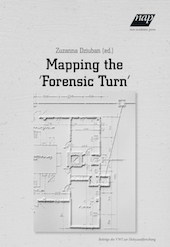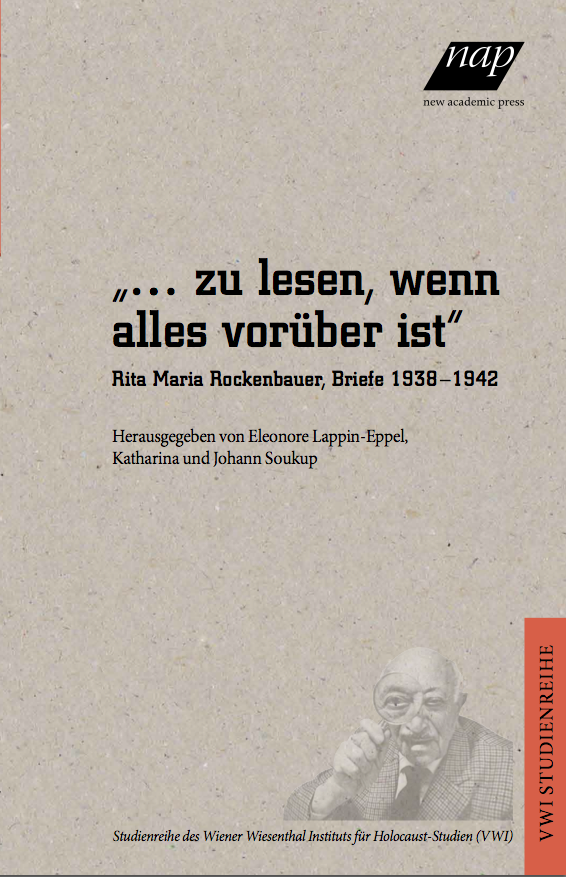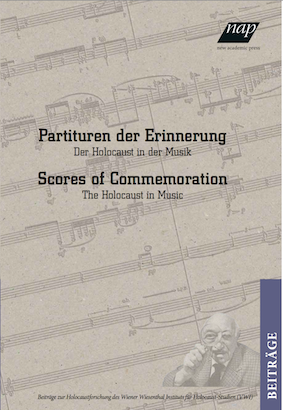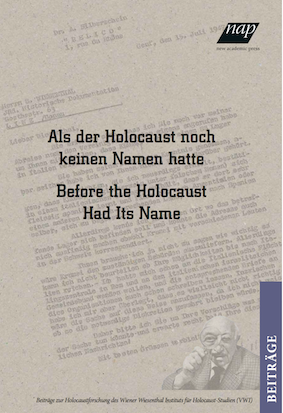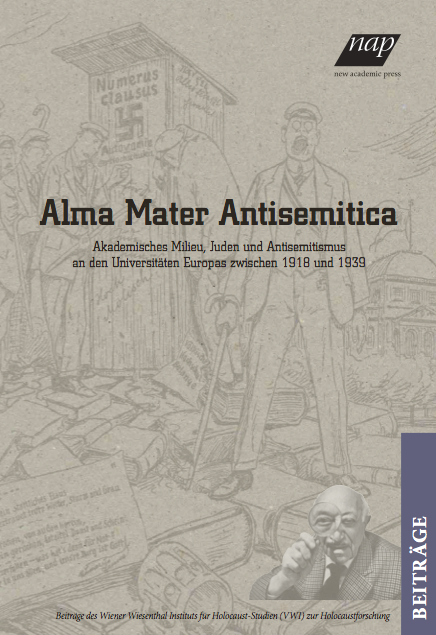 There is a paradox saying in contemporary Russia that a country's past cannot be predicted: the image of the Russian or Soviet past is always influenced by the interpretation of the current political situation. In order to be able to understand why Russia is once again in the smothering hold of an “unpredictable past” and why one's attitude to Stalin is still, 62 years after his death, the sole measure for a person's position on democracy and liberal values, we must take a closer look at the social conditions during the second half of the 1980s. This paper addresses that task. Its particular focus is the construction of an official state ideology from contradictory historical images by the ruling elites in contemporary Russia.
There is a paradox saying in contemporary Russia that a country's past cannot be predicted: the image of the Russian or Soviet past is always influenced by the interpretation of the current political situation. In order to be able to understand why Russia is once again in the smothering hold of an “unpredictable past” and why one's attitude to Stalin is still, 62 years after his death, the sole measure for a person's position on democracy and liberal values, we must take a closer look at the social conditions during the second half of the 1980s. This paper addresses that task. Its particular focus is the construction of an official state ideology from contradictory historical images by the ruling elites in contemporary Russia.
Editorial
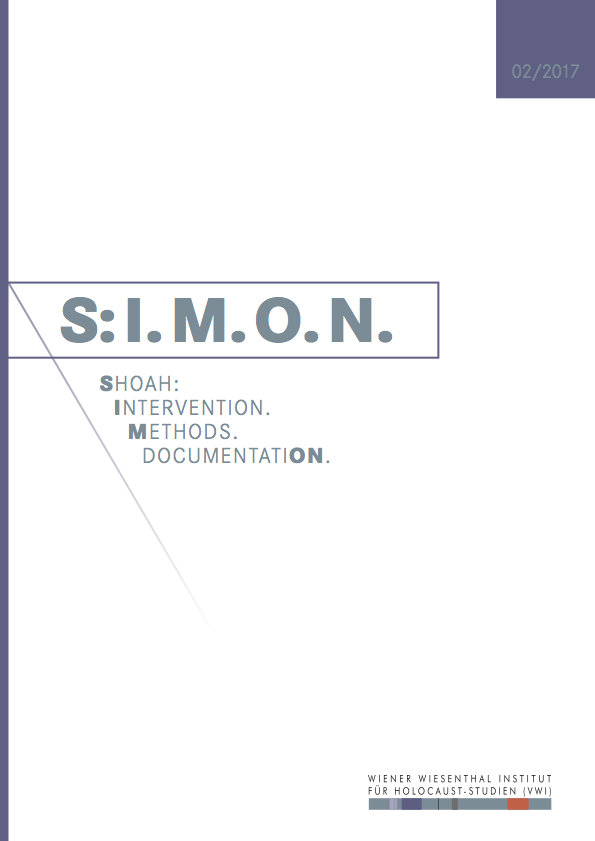 S:I.M.O.N. is an e-journal of the Vienna Wiesenthal Institute for Holocaust Studies (VWI). It appears twice a year in English and German language. S:I.M.O.N. aims at both a transnational and comparative history of the Holocaust and Jewish Studies in Central and Eastern Europe within the broader contexts of the European history of the 20th and 21st century, including its prehistory, consequences and legacies as well as the history of memory.
S:I.M.O.N. is an e-journal of the Vienna Wiesenthal Institute for Holocaust Studies (VWI). It appears twice a year in English and German language. S:I.M.O.N. aims at both a transnational and comparative history of the Holocaust and Jewish Studies in Central and Eastern Europe within the broader contexts of the European history of the 20th and 21st century, including its prehistory, consequences and legacies as well as the history of memory.
S:I.M.O.N. serves as a forum for discussion of various methodological approaches. The journal especially wishes to strengthen the exchange between researchers from different scientific communities and to integrate both the Jewish history and the history of the Holocaust into the different “national” narratives. It also lays a special emphasis on memory studies and the analysis of politics of memory. S:I.M.O.N. uses a double-blind review system, which means that both the reviewer’s and the author’s identities are concealed from each other hroughout the review process.
Shoah: The journal deals with the history of the Shoah from multidisciplinary, transnational and comparative perspectives. It seeks to integrate studies on Jews as well as on other groups of victims of the Holocaust, especially on Roma, and of so far less researched regions of (East) Central and (South) Eastern Europe.
Intervention. The journal reports on research projects and their transmission into public events. It also informs about current educational and remembrance programs.
Methods. The journal serves as a forum for the discussion of methodological approaches as, for instance, the everyday history, oral history, gender history, the history of violence, anti-Semitism and racism and the theory of memory and memory politics.
DocumentatiON. The journal contributes to critical approaches on using and interpreting archival materials in the 21st century.
Download the current issue S:I.M.O.N. 2017/2.
Articles
Gerhard Baumgartner
The Road Towards Genocide. The Process of Exclusion and Persecution of Roma and Sinti in the 1930s and 1940s
 The fate of the European Roma during the Holocaust, the murder of several hundreds of thousands of Roma and Sinti in the territories under control of the Third Reich – a genocide which by Roma and Sinti representatives is also referred to as 'Porrajimos' or 'Samusdripen' – now forms an accepted part of European historical discourse on the 20th century and has become the focal point of a new Europe-wide process of Roma identity formation. In its monstrosity and unprecedented brutality it is like a vast shadow cast upon the common history of Roma and Gadje alike, a memento of an unspeakably dehumanised past.
The fate of the European Roma during the Holocaust, the murder of several hundreds of thousands of Roma and Sinti in the territories under control of the Third Reich – a genocide which by Roma and Sinti representatives is also referred to as 'Porrajimos' or 'Samusdripen' – now forms an accepted part of European historical discourse on the 20th century and has become the focal point of a new Europe-wide process of Roma identity formation. In its monstrosity and unprecedented brutality it is like a vast shadow cast upon the common history of Roma and Gadje alike, a memento of an unspeakably dehumanised past.
Historians have reconstructed the events that culminated in these murderous acts in great detail, mapping the increasingly radical acts of marginalisation and persecution of people labelled as 'Zigeuner' ('Gypsies') by the authorities. This marginalisation started during the Romantic period, when Europeans were told to see 'Gypsies' as fundamentally different and exotic – the 'last savages of Europe'. This, combined with the emerging 'science' of eugenics, which declared these differences to be genetically determined and therefore immutable, prepared the ground for their marginalisation and exclusion from society, based on pseudoscientific concepts.
A severe social crisis caused by the global economic crisis of the 1930s, aggravated by the lack of adequate social welfare systems in Central and Eastern Europe at the time, led to clashes between the Roma and non-Roma populations, especially in the formerly Hungarian, now Austrian, Burgenland region. This later provided the justification for the Nazi administration's racist policies against Roma and Sinti, which eventually culminated in genocide. Some key ingredients in this catastrophe may seem strangely familiar now, as we can again encounter them in Europe today. Looking at the policies that paved the way for the Nazi genocide of the 'Gypsies', it becomes clear that many of today's policies and administrative practices affecting Roma, especially in Eastern Europe, are not that new after all and have worrying echoes in the past.
SWL-Reader
Karola Fings
Opferkonkurrenzen. Debatten um den Völkermord an den Sinti und Roma und neue Forschungsperspektiven
 In 1992, the government of the Federal Republic of Germany decided to dedicate a memorial to the victims of the genocide of Sinti and Roma. The Memorial for the Sinti and Roma of Europe murdered under National Socialism by the artist Dani Karavan was inaugurated in October 2012 in the centre of Berlin, near the former Reichstag building. The planning and construction phase spanned two decades, during which many discussions addressed the significance awarded to the Nazi persecution of “gypsies” next to the Holocaust. These discussions reached an apex in a controversy enacted via media between Yehuda Bauer (then the director of the International School for Holocaust Studies in Yad Vashem) and Romani Rose (the head of the Central Council of German Sinti and Roma). This paper critically reflects the debates in light of new research results on the genocide of Sinti and Roma.
In 1992, the government of the Federal Republic of Germany decided to dedicate a memorial to the victims of the genocide of Sinti and Roma. The Memorial for the Sinti and Roma of Europe murdered under National Socialism by the artist Dani Karavan was inaugurated in October 2012 in the centre of Berlin, near the former Reichstag building. The planning and construction phase spanned two decades, during which many discussions addressed the significance awarded to the Nazi persecution of “gypsies” next to the Holocaust. These discussions reached an apex in a controversy enacted via media between Yehuda Bauer (then the director of the International School for Holocaust Studies in Yad Vashem) and Romani Rose (the head of the Central Council of German Sinti and Roma). This paper critically reflects the debates in light of new research results on the genocide of Sinti and Roma.
Events
Zoltán Halasi
Duschehubka
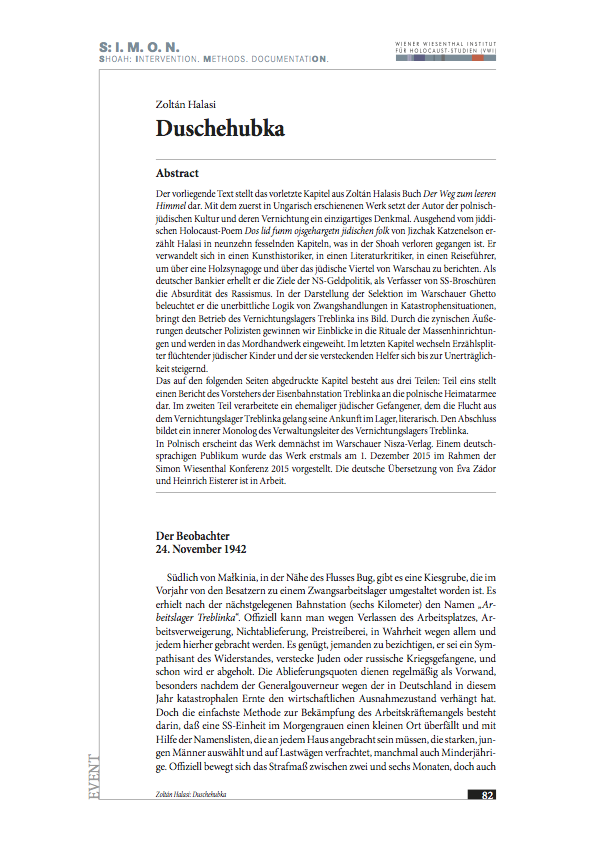 This text is the penultimate chapter of Zoltán Halasi's book Út az üres éghez (Road to an Empty Sky). With this work, which was first published in Hungarian, the author created a singular memorial to Polish-Jewish culture and its destruction. Setting out from the Yiddish Holocaust poem Dos lid funm ojsgehargetn jidischen folk by Itzhak Katzenelson, Halasi records what was lost in the Shoah in the course of nineteen compelling chapters. He takes on the grab of an art historian, a literary critic and a travel guide when he reports about a wooden synagogue and the Jewish quarter in Warsaw. In the role of a German banker, he illuminates the aims of the Nazi monetary policies, as a writer of SS brochures he highlights the absurdity of racism. Depicting a Selektion in the Warsaw ghetto, he shows the grim logic of compulsive acts in catastrophic situations, draws an image of the running of the extermination camp Treblinka. The cynical words of two German policemen provide an insight into the rituals of mass executions and introduce us to the craft of murder. The final chapter is an interplay of slithers of narrative by Jewish children on the run and by those who helped and hid them that borders on the unbearable.
This text is the penultimate chapter of Zoltán Halasi's book Út az üres éghez (Road to an Empty Sky). With this work, which was first published in Hungarian, the author created a singular memorial to Polish-Jewish culture and its destruction. Setting out from the Yiddish Holocaust poem Dos lid funm ojsgehargetn jidischen folk by Itzhak Katzenelson, Halasi records what was lost in the Shoah in the course of nineteen compelling chapters. He takes on the grab of an art historian, a literary critic and a travel guide when he reports about a wooden synagogue and the Jewish quarter in Warsaw. In the role of a German banker, he illuminates the aims of the Nazi monetary policies, as a writer of SS brochures he highlights the absurdity of racism. Depicting a Selektion in the Warsaw ghetto, he shows the grim logic of compulsive acts in catastrophic situations, draws an image of the running of the extermination camp Treblinka. The cynical words of two German policemen provide an insight into the rituals of mass executions and introduce us to the craft of murder. The final chapter is an interplay of slithers of narrative by Jewish children on the run and by those who helped and hid them that borders on the unbearable.
The chapter reproduced on the following pages has three parts: Part one is a Treblinka railway station master's report to the Polish Home Army. In the second part, a former Jewish detainee who managed to escape from the extermination camp Treblinka gives a literary treatment of his arrival at the camp. The final part consists of an inner monologue by the Treblinka extermination camp's director of administration.
The book will shortly be published in Polish at the Nisza publishing company in Warsaw. The German-speaking public was first presented with the work on December 1, 2015 at the Simon Wiesenthal Conference 2015. The German translation by Éva Zádor and Heinrich Eisterer is in progress.
Irina Scherbakowa: Erinnerung versus Verdrängung am Beispiel Russland. Vom schwierigen Umgang mit der Vergangenheit
„... zu lesen, wenn alles vorüber ist“
Rita Maria Rockenbauer, Briefe 1938 –1942
Wien 2014
Partituren der Erinnerung.
Der Holocaust in der Musik
Scores of Commemoration.
The Holocaust in Music
Wien 2015
Before the Holocaust Had Its Name. Early Confrontations of the Nazi Mass Murder of the Jews
Wien 2016
Akademisches Milieu, Juden und Antisemitismus an den Universitäten Europas zwischen 1918 und 1939
Academic Milieu, Jews and Antisemitism at European Universities between 1918 and 1939
Wien 2016


